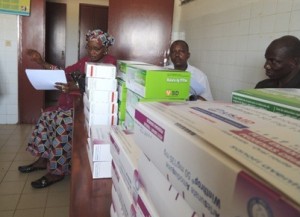Following an initial request from the National Malaria Control Program (NMCP), the U.S. President’s Malaria Initiative (PMI) and USAID funded the first emergency distribution of artemisinin-based combination therapies (ACTs) in late 2011.

A supervisor from the National Malaria Control Program explains the emergency distribution and the new reporting system to the chiefs of health centers in a district of Conakry. Source: SIAPS Staff.
In Guinea, malaria is a common threat year-round, especially during the rainy season that lasts from May to October. It affects everyone, but for children under five years of age, appropriate and immediate treatment could mean the difference between life and death.
Malaria accounts for 31% of consultations, 25% of hospitalizations, and 14% of deaths in health facilities among children according to Guinea national statistics. Unfortunately, Guinea struggles with an inconsistent supply of anti-malarial medicines, test kits, and preventive products, relying heavily on donors for obtaining such products. Even when the products arrive in country, financial and operational challenges often lead to delays in distribution to the various regions’ public health centers and hospitals.
Every day that a health facility spends without malaria treatment drugs, lives are put at risk.
Following an initial request from the National Malaria Control Program (NMCP), the U.S. President’s Malaria Initiative (PMI) and USAID funded the first emergency distribution of artemisinin-based combination therapies (ACTs) in late 2011. ACTs such as AS-AQ (artesunate-amodiaquine) are the first-line treatment for uncomplicated cases of malaria.
In response to new stock-outs in 2012 of medicines at many public health facilities, NMCP requested once again support from PMI and USAID in re-supplying the country with ACTs as well as rapid diagnostic test (RDT) kits which can be used to diagnose malaria not only in health centers but also at the community level.
SIAPS worked closely with the NMCP, the Central Pharmacy of Guinea (PCG), USAID partners MCHIP and Faisons Ensemble, Peace Corps volunteers and the regional health directors, ensuring a country-wide distribution in November 2012, even to the most remote areas. PCG arranged the advanced shipment of products to its regional warehouses and ensured delivery to all 38 health districts, where the chiefs of health facilities met to collect the products.
Over 400 centers, hospitals and some military clinics benefited directly from ACTs and RDTs. Estimates of medicines and products needed had been collected in advance of the emergency distribution through workshops and by phone. The quantity given to each facility depended on its average use of ACTs over time, and its remaining stock.
In order to avoid future stock-outs of products, this distribution was used as an opportunity to introduce monthly reporting forms and tools that would ensure a more consistent flow of information from the health facility to the district level and from there to the central level.
Moving forward, health facilities will be resupplied with malaria products after sending monthly reports detailing the number of medicines given to patients. The data will allow NMCP and the Ministry of Health to better plan for the proper quantity of products that should be sent to the local level, and how much to acquire for the country in general, reducing the risk of shortages.
Not only did the emergency distribution provide a short-term solution, but it started a longer-term procurement and supply solution. SIAPS is working with the PNLP and PCG to ensure the regular delivery of medicines and commodities to the regions, especially as a significant amount of additional products funded by PMI and USAID have arrived in Guinea or are expected shortly. In total, 755,000 doses of ACTs for all age groups, 1.1 million RDTs, 375,000 doses of sulfadoxine-pyrimethamine (SP) for preventive treatment of pregnant women, and 40,000 doses of injectable quinine for severe malaria will be provided to beneficiaries (many of them children) at no cost over the next year – helping advance PMI’s goal of reducing malaria deaths by 50% in Guinea by the end of 2015.
This story was taken from www.siapsprogram.org
